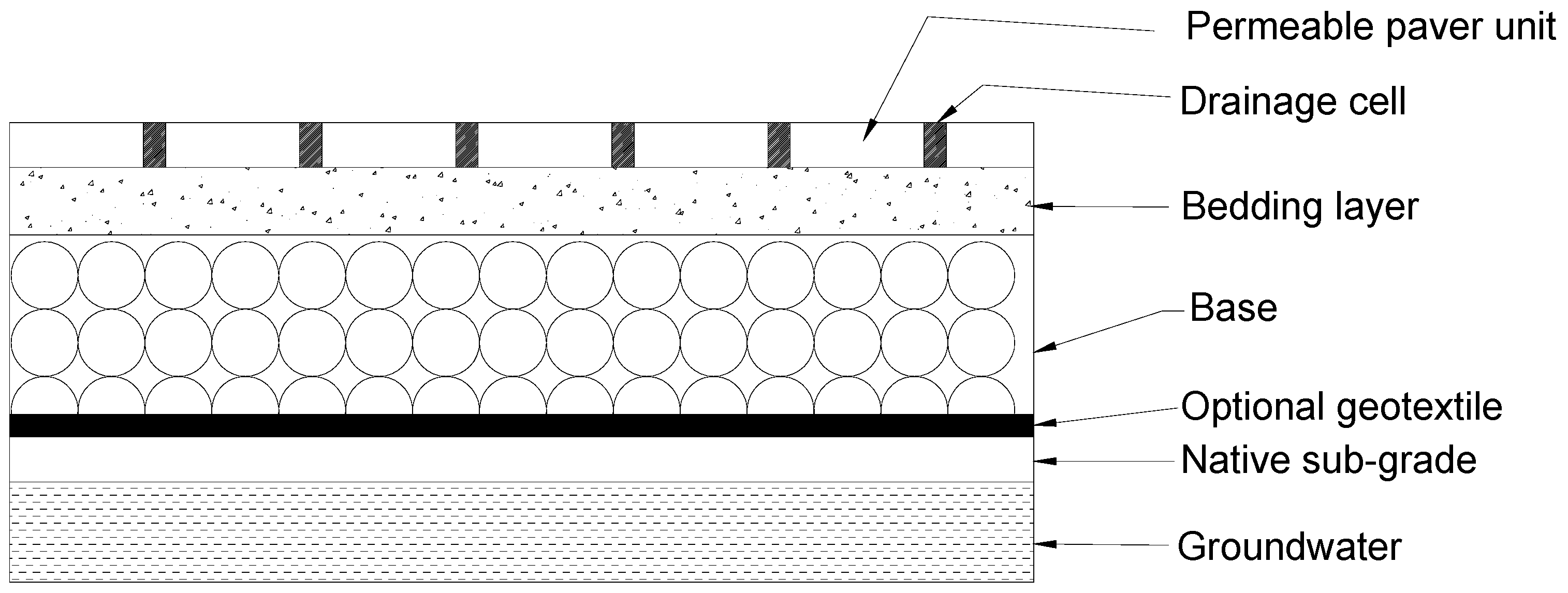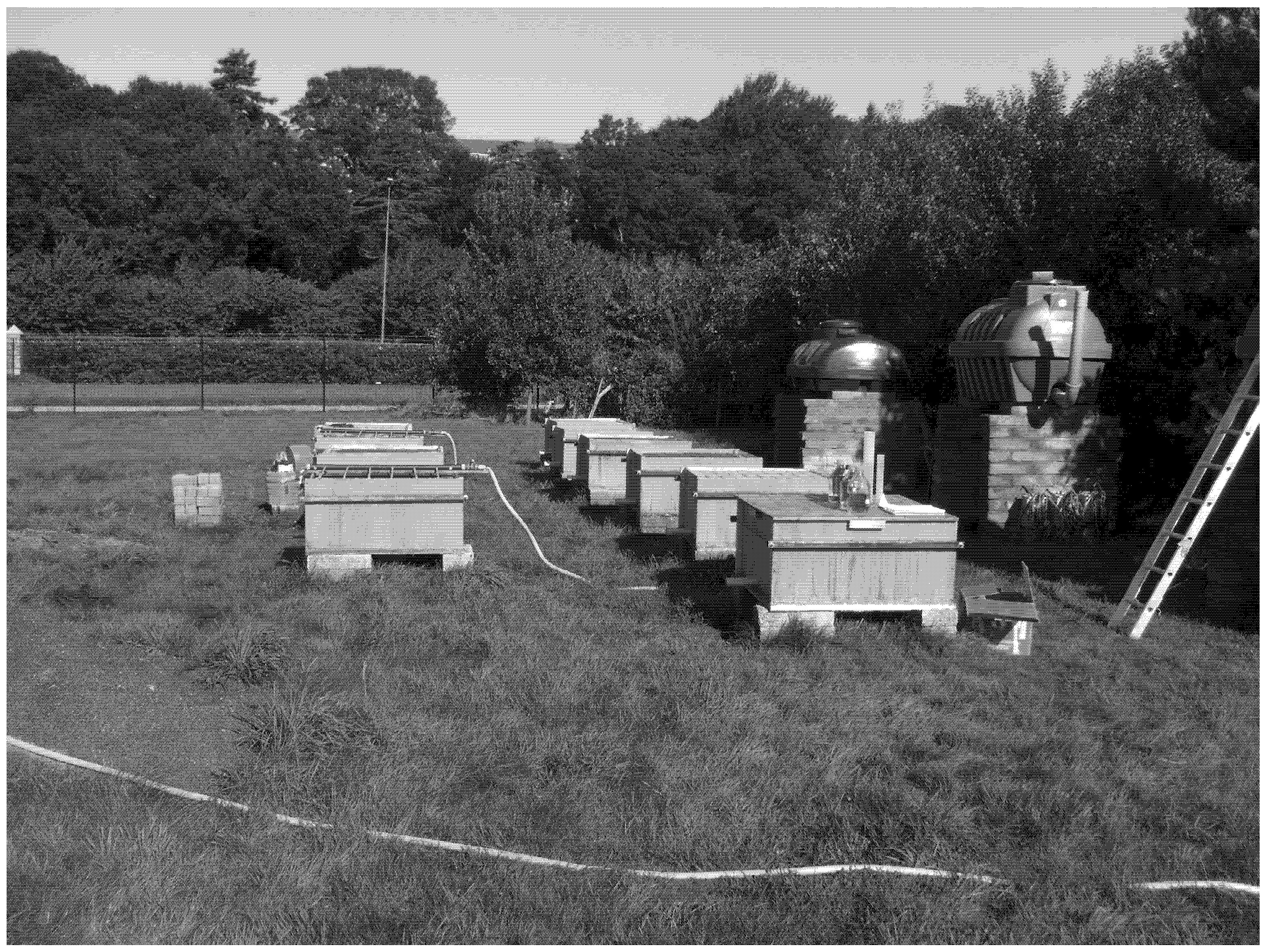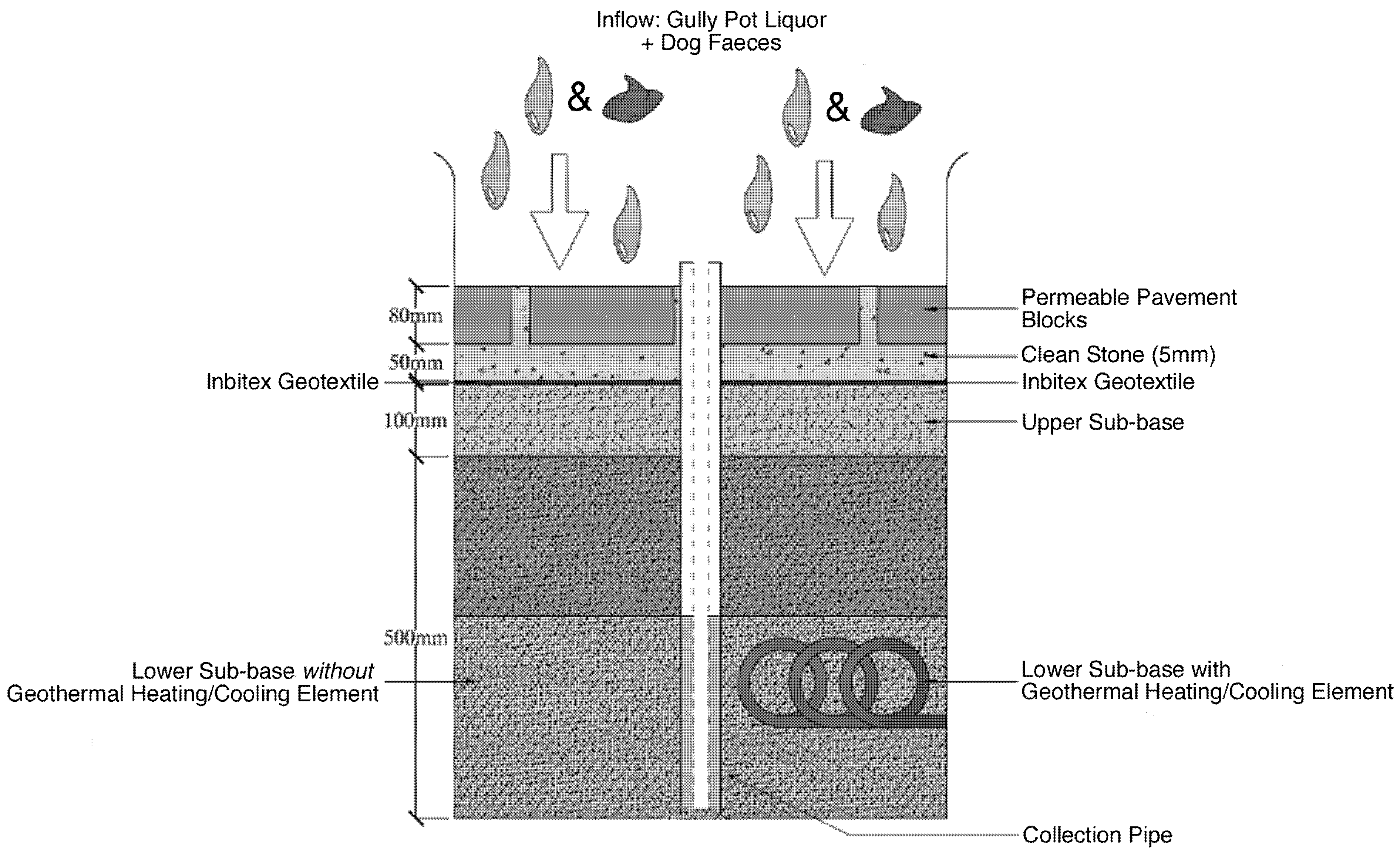Water Quality Improvement Performance of Geotextiles Within Permeable Pavement Systems: A Critical Review
Abstract
:1. Introduction
1.1. Background

1.2. Rationale, Aim and Objectives
- To conduct a review of geotextiles within the SuDS context;
- To briefly assess recent permeable pavement system research;
- To critically review selected research projects on geotextiles within permeable pavement systems undertaken for the concrete and aggregate industry;
- To draw conclusions based on the critical literature review; and
- To recommend further research work.
2. Critical Review of Geotextiles in the Context of Permeable Pavements
2.1. Relevant Types of Geotextiles
2.2. Geotextile Applications and Their Properties of Relevance for Permeable Pavements
3. Assessment of Permeable Pavement Systems
3.1. Need for a Permeable Pavement Systems Review
3.2. Removal of Heavy Metals
3.3. Removal of Oils
3.4. Removal of Suspended Solids
3.5. Removal of Other Parameters
4. Critical Review of the “Abertay Study”
4.1. Essential Background
4.2. Summary of Methodology

4.3. Review of Key Findings
4.4. Summary of the Conclusions
4.5. Critical Assessment of the ‘Abertay Study’
- The test rigs were located above the ground (Figure 2), which exposed them to unrealistic environmental conditions such as high temperature fluctuations and enhanced wind exposure impacting on removal processes. In terms of water quality, removal rates are over-estimated during warm periods and under-estimated during cold periods.
- The simulation of multiple years of pollution represents the application of a series of severe one-off shock loads. Most pollutants were simply being forced hydraulically through the system, and very little biodegradation activities took place. Moreover, total metal adsorption is lower than under long-term test conditions. Accelerating loading by increasing contaminant concentrations also affects the corresponding sorption isotherms, which were not determined in this study.
- The combination of different pollution loads simulates worst case scenarios in parallel and in series. The testing period of about two months is too short to represent different seasons and allow representative biomass to mature in the systems.
- The hydraulic flow rate and both the loads and concentrations of most pollutants selected were too high.
5. Critical Review of the ‘Edinburgh Study’
5.1. Essential Background
5.2. Summary of Methodology

| Feature | Bins of the inside rig | Bins of the outside rig | ||||||||||
|---|---|---|---|---|---|---|---|---|---|---|---|---|
| 1 | 2 | 3 | 4 | 5 | 6 | 1 | 2 | 3 | 4 | 5 | 6 | |
| Inbitex composite | √ | √ | √ | √ | √ | √ | ||||||
| Inbitex geotextile | √ | √ | √ | √ | √ | √ | ||||||
| Cooling or heating | √ | √ | √ | √ | √ | √ | √ | √ | ||||
| Animal feaces added | √ | √ | √ | √ | ||||||||
| Air thermometer | √ | √ | √ | √ | √ | √ | ||||||
| Vessel thermometer | √ | √ | √ | √ | ||||||||
| Carbon dioxide sampling point | √ | √ | √ | √ | ||||||||
5.3. Review of Key Findings
5.4. Summary of Conclusions
5.5. Critical Assessment of the Edinburgh Study
6. Conclusions
7. Recommendations for Further Research
Acknowledgments
References
- Scholz, M. Wetland Systems to Control Urban Runoff; Elsevier: Amsterdam, The Netherlands, 2006. [Google Scholar]
- Scholz, M. Wetland Systems—Storm Water Management Control; Springer Verlag: Berlin, Germany, 2010. [Google Scholar]
- Scholz, M.; Grabowiecki, P. Combined permeable pavement and ground source heating pump systems to treat urban runoff. J. Chem. Technol. Biotechnol. 2009, 84, 405–413. [Google Scholar] [CrossRef]
- Scottish Government, The Water Environment (Controlled Activities) (Scotland) Regulation; Scottish Government, The National Archives: Edinburgh, Scotland, UK, 2011. Available online: http://www.legislation.gov.uk/ssi/2011/209/contents/made (accessed on 16 May 2012).
- McLean, N.; Marshalls. SEPA. E-Mail Communication. 5 February 2008. [Google Scholar]
- Holtz, R.D. Geosynthetics for soil reinforcement. In Frontier Technologies for Infrastructures Engineering: Structures and Infrastructures; Chen, S., Ang, A.H., Eds.; Taylor and Francis Group: London, UK, 2009. [Google Scholar]
- John, N.W.M. Geotextiles; Blackie and Son: London, UK, 1987. [Google Scholar]
- Cook, D.I. Geosynthetics; Rubber and Plastics Research Association Technology Limited: Shrewsbury, UK, 2003. [Google Scholar]
- Boving, T.B.; Stolt, M.H.; Augenstern, J.; Brosnan, B. Potential for localized groundwater contamination in a porous pavement parking lot setting in Rhode Island. Environ. Geol. 2008, 55, 571–582. [Google Scholar] [CrossRef]
- Tota-Maharaj, K.; Scholz, M.; Ahmed, T.; French, C.; Pagaling, E. The synergy of permeable pavements and geothermal heat pumps for stormwater treatment and reuse. Environ. Technol. 2010, 31, 1517–1531. [Google Scholar] [CrossRef]
- Raymond, G.P.; Bathurst, R.J. Facilitating cold climate pavement drainage using geosynthetics. In Testing and Performance of Geosynthetics in Subsurface Drainage; Suits, L.D., Goddard, J.B., Baldwin, J.S., Eds.; American Society for Testing and Materials Special Technical Publication: West Conshohocken, PA, USA, 2000; Volume 1390, pp. 52–63. [Google Scholar]
- Jersey, S.R.; Tingle, J.S. Geotextile response to common index property tests. Transport. Res. Rec. 2007, 1989, 102–112. [Google Scholar] [CrossRef]
- BSI, Geotextiles and Geotextile-related Products. Characteristics Required for Use in Drainage Systems; The British Standards Institution: London, UK, 2001; Standard BS EN 13252:2001; Available online: http://shop.bsigroup.com/ProductDetail/?pid=000000000030144789 (accessed on 10 May 2012).
- The British Standards Institution (BSI), Geotextiles and Geotextile-related Products. Characteristics Required for Use in the Construction of Roads and Other Trafficked Areas (Excluding Railways and Asphalt Inclusion); BSI: London, UK, 2001; Standard BS EN 13249:2001; Available online: http://shop.bsigroup.com/ProductDetail/?pid=000000000030144365 (accessed on 10 May 2012).
- Narejo, D.B. Opening size recommendations for separation geotextiles used in pavements. Geotext. Geomemb. 2003, 21, 257–264. [Google Scholar] [CrossRef]
- Shukla, S.K. Geosynthetics and Their Applications; Thomas Telford Publishing: London, UK, 2002. [Google Scholar]
- Scholz, M.; Grabowiecki, P. Review of permeable pavement systems. Build. Environm. 2007, 42, 3830–3836. [Google Scholar] [CrossRef]
- Coupe, S.J.; Smith, H.G.; Newman, A.P.; Pühmeier, T. Biodegradation and microbial diversity within permeable pavements. Eur. J. Protistol. 2003, 39, 495–498. [Google Scholar] [CrossRef]
- Pühmeier, T.; Newman, A.P. Oil retaining and treating geotextile for pavement application. In Proceedings of the 11th International Conference on Urban Drainage, Edinburgh, UK, 31 August–5 September 2008.
- Newman, A.P.; Pühmeier, T.; Kwok, V.; Lam, M.; Coupe, S.J.; Shuttleworth, A.; Pratt, C.J. Protecting groundwater with oil-retaining pervious pavements: Historical perspectives, limitations and recent developments. Quart. J. Eng. Geol. Hydrogeol. 2004, 37, 283–291. [Google Scholar] [CrossRef]
- Pratt, C.J.; Mantle, D.G.; Schofield, P.A. UK research into the performance of permeable pavement, reservoir structures in controlling stormwater discharge quantity and quality. Water Sci. Technol. 1995, 32, 63–69. [Google Scholar]
- Tota-Maharaj, K.; Scholz, M. Artificial neural network simulation of combined permeable pavement and earth energy systems treating storm water. J. Environ. Eng. ASCE 2012, 138, 499–509. [Google Scholar] [CrossRef]
- Legret, M.; Colandini, V.; LeMarc, C. Effects of a porous pavement with reservoir structure on the quality of runoff water and soil. Sci. Total Environ. 1996, 190, 335–340. [Google Scholar] [CrossRef]
- Gilbert, J.K.; Clausen, J.C. Stormwater runoff quality and quantity from asphalt, paver, and crushed stone driveways in Connecticut. Water Res. 2006, 40, 826–832. [Google Scholar] [CrossRef]
- Dierkes, C.; Lohmann, M.; Becker, M.; Rassch, U. Pollution retention of different permeable pavements with reservoir structure at high hydraulic loads. In Proceedings of the 10th International Conference on Urban Drainage, Copenhagen, Denmark, 21–26 August 2005.
- Rowe, A.A.; Borst, M.; O’Connor, T.P. Pervious pavement system evaluation. In Proceedings of the World Environmental and Water Resources Congress 2009, Great Rivers, MI, USA, 17–21 May 2009; Starrett, S., Ed.; American Society of Civil Engineers: Reston, VA, USA, 2009; pp. 1–8. [Google Scholar]
- Pratt, C.J.; Newman, A.P.; Bond, P.C. Mineral oil bio-degradation within a permeable pavement: long term observations. Water Sci. Technol. 1999, 39, 103–109. [Google Scholar]
- Newman, A.P.; Coupe, S.J.; Henderson, J.; Morgan, J.A.; Pühmeier, T.; Pratt, C.J. Oil retention and microbial ecology in porous pavement structures. In Presented at the European Forum of Environmental Research Laboratories, Campus Ker Lann, Rennes, France, 2001; Available online: http://perviousconsulting.com/resources/Microbial%2BEcology%2BIn%2BPorous%2BPavement.pdf (accessed on 3 May 2012).
- Newman, A.P.; Pratt, C.J.; Coupe, S.J.; Cresswell, N. Oil bio-degradation in permeable pavements by microbial communities. Water Sci. Technol. 2002, 45, 51–56. [Google Scholar]
- Yong, C.F.; Deletic, A.; Fletcher, T.D.; Grace, M.R. The clogging behavior and treatment efficiency of a range of porous pavements. In Proceedings of the 11th International Conference on Urban Drainage, Edinburgh, UK, 31 August–5 September 2008.
- Fernández-Barrera, A.H.; Castro-Fresno, D.; Rodriguez-Hernandez, J.; Calzada-Pérez, M.A. Infiltration capacity assessment of urban pavements using the LCS permeameter and the CP infiltrometer. J. Irrig. Drain. Eng. 2008, 134, 659–665. [Google Scholar] [CrossRef]
- Brown, C.; Chu, A.; van Duin, B.; Valeo, C. Characteristics of sediment removal in two types of permeable pavement. Water Qual. Res. J. Can. 2009, 44, 59–70. [Google Scholar]
- Gomez-Ullate, E.; Castillo-Lopez, E.; Castro-Fresno, D.; Bayon, J.R. Analysis and contrast of different pervious pavements for management of storm-water in a parking area in Northern Spain. Water Resour. Manag. 2011, 25, 1525–1535. [Google Scholar] [CrossRef]
- Gomez-Ullate, E.; Bayon, J.R.; Coupe, S.; Castro-Fresno, D. Performance of pervious pavements parking bays storing rainwater in the north of Spain. Water Sci. Technol. 2010, 62, 615–621. [Google Scholar] [CrossRef]
- Gomez-Ullate, E.; Novo, A.V.; Bayon, J.R.; Rodriguez-Hernandez, J.; Castro-Fresno, D. Design and construction of an experimental pervious paved parking area to harvest reusable rainwater. Water Sci. Technol. 2011, 64, 1942–1950. [Google Scholar] [CrossRef]
- Stotz, G.; Krauth, K. The pollution of effluents from pervious pavements of an experimental highway section: First results. Sci. Total Environ. 1994, 146–147, 465–470. [Google Scholar]
- Mbanaso, F.U.; Coupe, S.J.; Charlesworth, S.M.; Nnadi, E.O. Laboratory-based experiments to investigate the impact of glyphosate-containing herbicide on pollution attenuation and biodegradation in a model pervious paving system. Chemosphere 2013, 90, 737–746. [Google Scholar] [CrossRef]
- Mullaney, J.; Jefferies, C.; Mackinnon, E. The performance of block paving with and without geotextile in the sub-base. In Proceedings of 12nd International Conference on Urban Drainage, Porto Alegre, Brazil, 11–15 September 2011.
- Mullaney, J.; Rikalainen, P.; Jefferies, C. Pollution profiling and particle size distribution within permeable paving units—With and without a geotextile. Manag. Environ. Qual. Int. J. 2012, 23, 150–162. [Google Scholar] [CrossRef]
- Construction Industry Research and Information Association (CIRIA), Control of Pollution from Highway Drainage Discharges; Report 142; Luker, M.; Monague, K. (Eds.) CIRIA: London, UK, 1994.
- Duncan, H.P. Urban Stormwater Quality: A Statistical Overview; Cooperative Research Centre for Catchment Hydrology: Melbourne, Australia, 1999. [Google Scholar]
- The British Standards Institution (BSI), Aggregates for Unbound and Hydraulically Bound Materials for Use in Civil Engineering Work and Road Construction; BSI: London, UK, 2002; Standard BS EN 13242:2002+A1:2007; Available online: http://shop.bsigroup.com/en/ProductDetail/?pid=000000000030147952 (accessed on 10 May 2012).
- The British Standards Institution (BSI), Pavements Constructed with Clay, Natural Stone or Concrete Pavers. Guide for the Design of Permeable Pavements Constructed with Concrete Paving Blocks and Flags, Natural Stone Slabs and Sets and Clay Pavers; BSI: London, UK, 2009; Standard BS 7533-13:2009; Available online: http://shop.bsigroup.com/ProductDetail/?pid=000000000030159352 (accessed on 10 May 2012).
© 2013 by the authors; licensee MDPI, Basel, Switzerland. This article is an open access article distributed under the terms and conditions of the Creative Commons Attribution license (http://creativecommons.org/licenses/by/3.0/).
Share and Cite
Scholz, M. Water Quality Improvement Performance of Geotextiles Within Permeable Pavement Systems: A Critical Review. Water 2013, 5, 462-479. https://doi.org/10.3390/w5020462
Scholz M. Water Quality Improvement Performance of Geotextiles Within Permeable Pavement Systems: A Critical Review. Water. 2013; 5(2):462-479. https://doi.org/10.3390/w5020462
Chicago/Turabian StyleScholz, Miklas. 2013. "Water Quality Improvement Performance of Geotextiles Within Permeable Pavement Systems: A Critical Review" Water 5, no. 2: 462-479. https://doi.org/10.3390/w5020462





